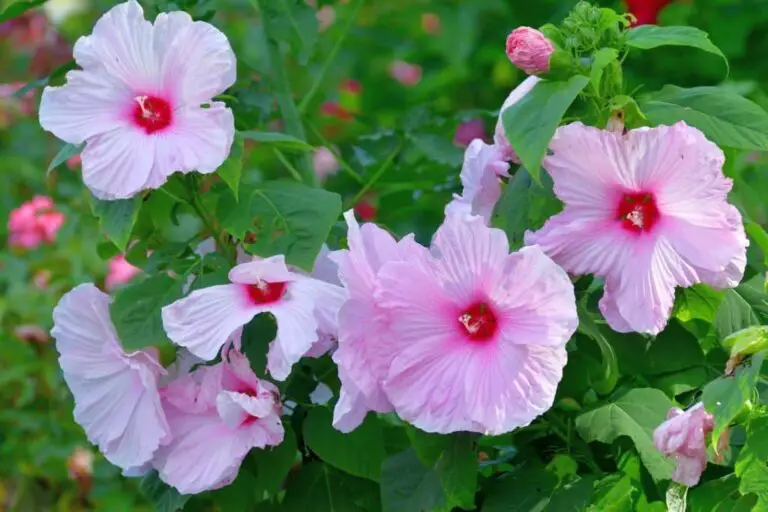Types Of Lilies: 51+ Beautiful Varieties With Facts & Pictures
Lilies, with their delicate charm and captivating beauty, are a popular choice for gardens, vases, and arrangements. But what sets them apart from other flowers is the sheer variety of types to choose from, each with its unique characteristics. From symbolic meanings in European and Asian cultures to the different divisions within lily types, there’s more to lilies than meets the eye.
In this article, we’ll delve into the world of lilies, exploring the various types, their differences, and what makes them special. The lily family is diverse, with numerous hybrids and species offering a range of colors, shapes, and sizes. We’ll take you on a journey through the different divisions, highlighting some of the most popular and unique varieties. Whether you’re looking for a specific type or simply want to learn more about these enchanting flowers, we’ve got you covered.
In addition to exploring the many types of lilies, we’ll also touch on related topics such as the difference between daylilies and lilies, the most fragrant lily varieties, and what symbols they represent. We’ll also answer common questions like how often a lily blooms and whether it will return year after year.
How many types of lilies are there?
The complexity in categorizing lily types stems from the fact that some cultivars can be misidentified as distinct species. In reality, there exist over 150 varieties of lilies (and counting). However, when grouping them based on similar characteristics and care requirements, the number of distinct types reduces to around ten.
Division 1: Asiatic Hybrids
Lilies are renowned for being the simplest to cultivate and boasting an unparalleled array of vibrant blooms. Their remarkable characteristics can be attributed to their hybrid makeup. If you’re looking to plant one, it’s worth getting acquainted with these exceptional Asiatic hybrids.
Black Out

The ‘Dark Red’ variety of flowers boasts a striking appearance, characterized by its dark red blooms featuring dark red to black centers. As the seasons transition into summer, these blossoms burst forth in an upward direction, with five blooms per stem providing a visually appealing display. Moreover, this particular type of flower is known for being self-seeding, allowing it to return each year, as if on cue.
Brunello

This stunning plant boasts a unique appearance, characterized by recurving tips and vibrant orange blooms accompanied by dark red stamens. At its peak, the flowers take on a bowl-like shape, with petals facing upwards towards the sky. The blooms themselves are quite expansive, spanning around 8 inches in diameter, while the stems can support up to 12 individual flowers.
Perhaps most impressively, this plant produces an abundance of blooms throughout the entire summer season, growing to a height of approximately 3 feet.
Citronella

The bright yellow, downward-facing blooms of this flower are distinguished by dark red freckles scattered throughout. Over time, these flowers form clumps, typically comprising at least 20 individual stems. In terms of timing, they begin blooming in early to mid-summer and reach a height of around 5 feet tall.
Dot Com

This stunning plant produces an impressive display of large, showy flowers that can reach up to 9 in number per stem. The blossoms typically measure between white and a deep purple-pink hue, with distinctive burgundy spots radiating from the center. As the plant grows to a height of around 3ft, it’s not uncommon for multiple stems to produce a profusion of flowers throughout the summer season, with the blooming period typically occurring from early to mid-summer.
Fire King
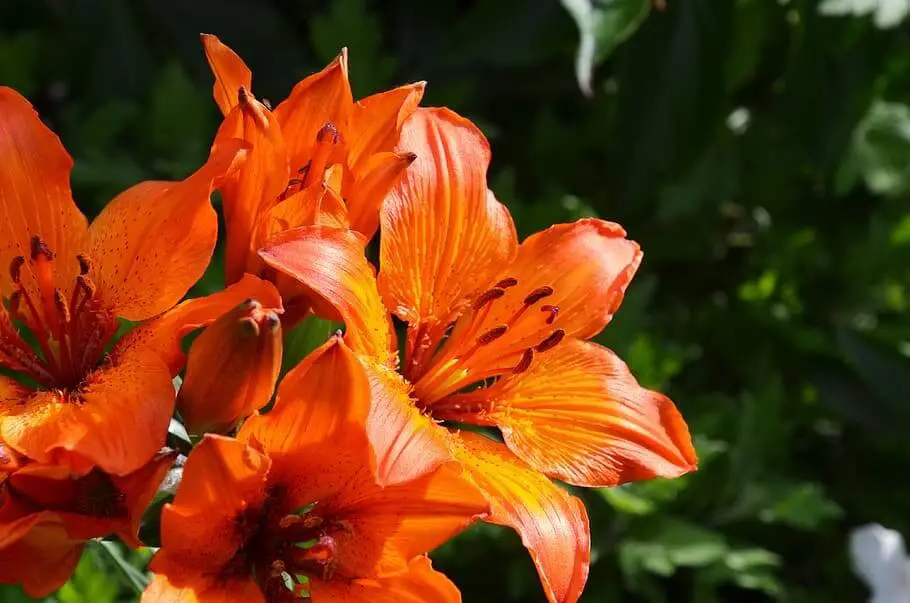
This vibrant plant injects a touch of tropical essence into the garden with its striking red-orange blooms, reminiscent of a fiery blaze. Its unique characteristic lies in its ability to self-seed, ensuring a perpetual display of colorful flowers from late spring through early summer, reaching an impressive height of 4ft.
Grand Cru

Characterized by its vibrant red blooms and rich burgundy centers, this plant boasts a unique appearance. Its ability to self-seed means it will return year after year, producing flowers from early to mid-summer. Reaching a height of up to 4 feet, this plant is well-suited for gardens of various sizes.
Montenegro

The tulipa gesneriana, commonly referred to as the Red Emperor or Emperor Tulip, is a standout bouquet flower due to its unique blooms featuring recurved tips, vibrant red petals, and striking black spots clustered at the center. What’s more, each stem can produce an impressive 10 flowers throughout the early to mid-summer period, making it a coveted addition to any floral arrangement.
Black Spider

The Lily ‘Prolific Blooming’ boasts a distinctive appearance, characterized by creamy yellow petals adorned with rich burgundy spots. The flower’s dark centre adds an extra layer of visual interest. Reaching heights of up to 3 feet (90 cm), this variety thrives during the early to mid-summer period, producing seven blooms per stem.
Gran Paradiso

The Scarlet Sage (Salvia coccinea) boasts a striking appearance, featuring an upside-down flower arrangement with curved tips and saucer-like, deeply hued red petals accompanied by vibrant orange centers. This eye-catching bloom typically emerges in mid to late summer, reaching a height of approximately 4 feet tall.
King Pete

The brightly colored, upward-facing blooms of this flower are characterized by their wide-open petals. A striking feature is the dark yellow center, complemented by delicate brown freckles that add texture to its appearance. As an added bonus, this self-seeding variety thrives from early to mid-summer, providing a vibrant display for several weeks.
Patricia’s Pride

Purple Rain, a majestic bloom, boasts an upward-facing, wide-opening arrangement featuring delicate white petals and a striking burgundy-purple center. This stunning flower unfolds its beauty annually, typically between early summer and the peak of the season, around mid-July.
Division 2: Martagon Hybrids

Turk’s Caps lilies are celebrated for their unique characteristic of producing small, whorled flowers that cascade downwards. These early blooming plants have a special affinity for shaded environments and can even thrive in frosty conditions. Although they may require some time to establish themselves in new settings, once adapted, they can persist for a prolonged period.
Arabian Knight

The striking appearance of this plant is characterized by its clusters of golden-brown flowers featuring distinctive dark mahogany brown spots. Notably, each stem has the capacity to support a minimum of 50 blooms, all oriented downwards. This plant’s flowering period spans the entire summer season, with the added benefit that it can self-seed annually, ensuring a consistent display of color year after year.
Claude Shride

The rare plant’s foliage boasts a unique blend of warm, earthy tones, transitioning seamlessly from dark red to rich brown mahogany hues. Scattered throughout are vibrant orange freckles that add a pop of color to the overall aesthetic. The plant’s flowers, which bloom annually from early to mid-summer, face downwards, creating an intriguing visual display. Notably, it possesses the ability to self-seed, allowing it to propagate naturally.
In terms of its physical stature, the plant reaches a maximum height of approximately 6 feet tall.
Manitoba Morning

The tubular flower of this variety is a striking feature, boasting an attractive reddish-pink hue, complemented by dark brown freckles and a bright yellow center. What’s more impressive is the sheer quantity of blooms it produces – each stem yields around 50 downward-facing flowers from early to mid-summer, providing a vibrant display that can’t be missed.
Martagon Mix
For nature lovers seeking a true showstopper among Martagnons, this hybrid variety is the ultimate choice for naturalization. Its unique feature is the way its downward-facing flowers with recurved tips cascade beautifully from their stems, displaying an incredible array of colors including yellow, purple, pink, orange, red, white, and even bi-colored varieties during the summer months.
Division 3: Candidum Hybrids
For centuries, records of the pure white lily’s parentage have been well-documented, dating back an astonishing 4,000 years. Originating in Europe, specifically Greece and the Balkan region, these candidum hybrids have thrived for millennia. As a testament to their enduring popularity, they bloom from late spring to early summer, their pristine white petals accompanied by a subtle yellow base, a characteristic that has captivated botanists and enthusiasts alike.
June Fragrance
This rare species is distinguished by its exquisite, large, and intensely fragrant white flowers. While it’s capable of thriving in cooler climates, it requires careful protection measures to withstand even moderate cold temperatures. The plant blooms from late May to mid-June, a period which has led to the origin of its name.
Nankeen

This particular plant stands out due to its striking lance-shaped leaves. The real showstopper, however, is the vibrant display of apricot-orange flowers, characterized by deep red stripes that run from the center outwards. Furthermore, this plant has a remarkable ability to thrive in dry conditions, producing blooms throughout the summer months.
Division 4: American Hybrids

Derived from the majestic white lilies native to North America, this particular type of lily is renowned for its unique blooming patterns. In areas characterized by high humidity and warmer temperatures, these lilies typically burst forth with vibrant blooms in late spring. Conversely, regions with milder climates can expect a mid-summer showstopper as the same species flourishes under the warmth of the sun.
Among the most celebrated American hybrids is the Bellingham variety, boasting an impressive display of color and beauty.
Division 5: Longiflorum and Easter Hybrids
Easter lilies, also referred to as white lilies, have been a staple of Easter decorations across many cultures. Interestingly, these beautiful blooms originate from Japan and Taiwan, where they’re known for their striking trumpet-shaped flowers that fill the air with a sweet fragrance. What sets them apart is their unique requirement for containers only – unlike other lily varieties, they lack the hardiness to thrive in open soil.
White Heaven

The Datura wrightii’s most striking feature is its showy, trumpet-shaped flowers, boasting pure white petals with a distinctive yellowish center and vibrant orange-yellow stamens that can grow remarkably long, up to 17 inches. Not only are these blooms outward-facing, but they also emit a sweet fragrance, making them all the more captivating. As an added bonus, this stunning display typically appears in mid-to-late summer.
Brindisi
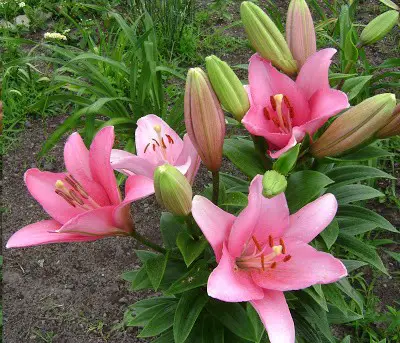
This exquisite bloom boasts a striking all-pink hue, characterized by a predominantly baby pink tone that subtly shifts into deeper shades towards its center. As it reaches maturity, this beauty stands tall at approximately 4 feet, producing an impressive seven blooms per stem. Its vibrant coloration remains consistent throughout the summer months.
White American

When the plant reaches maturity, its blooms unfurl to a stunning size of approximately 5 inches in diameter. Characterized by their pure white petals and yellow anthers adorned with green tips, these recurved flowers face upwards towards the sky. What’s more impressive is that each stem produces a cluster of 8 individual blooms throughout the early to mid-summer season.
Division 6: Trumpet and Aurelian Hybrids
Both Lily types in this category share similar care needs and traits, earning them a spot together. Despite their clustering, they do have one distinct requirement: full sun. Unfortunately, this also means they’re not cold-hardy. As the summer season unfolds, you can expect these varieties to burst forth with an abundance of pink, elongated blooms that resemble closed-trumpet or tubular flowers.
African Queen

The striking apricot-orange blooms of these exotic lilies are a sight to behold. As they reach heights of up to 3 feet, their trumpet-shaped flowers emit a fragrant scent that’s perfect for adding a touch of elegance to vases and arrangements. With mid-summer to late summer blooms, these eye-catching flowers bring a pop of color to any garden setting.
Regale

The Lycoris radiata, also known as the Red Spider Lily, is renowned for its captivating aroma and striking appearance. Its trumpet-shaped flowers, which face outward, boast a stunning white hue with distinctive gold centers and delicate streaks of pink and purple. A highlight of this plant’s beauty is its mid-summer blooming period, making it a standout in any garden or arrangement.
Golden Splendor
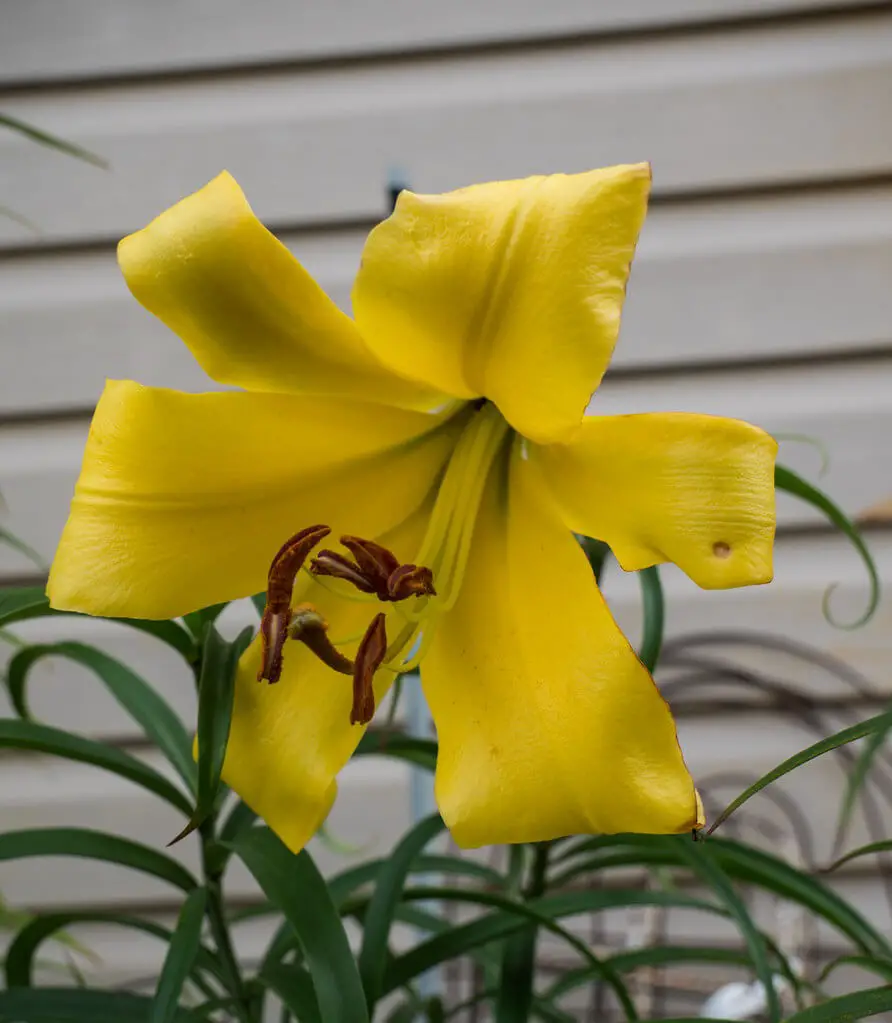
This esteemed lily has garnered recognition from prominent international horticultural organizations, earning it an award. Its striking appearance is characterized by trumpet-shaped blooms with a warm, golden brown hue and a deep burgundy underside. The flowers face outwards, with each stem producing 20 clusters of blooms throughout the summer months.
Pink Perfection

The majestic flower boasts a striking trumpet-shaped appearance, with a delicate balance of purple-pink hues and crisp white edges. Its intoxicating fragrance wafts through the air, captivating senses throughout the summer months. Notably, this lily variety proves more heat-tolerant than many of its peers, making it an excellent choice for gardeners seeking low-maintenance beauty. Each stem is a treasure trove, producing at least 20 clusters of showy blooms that are sure to delight.
Division 7: Oriental Hybrids
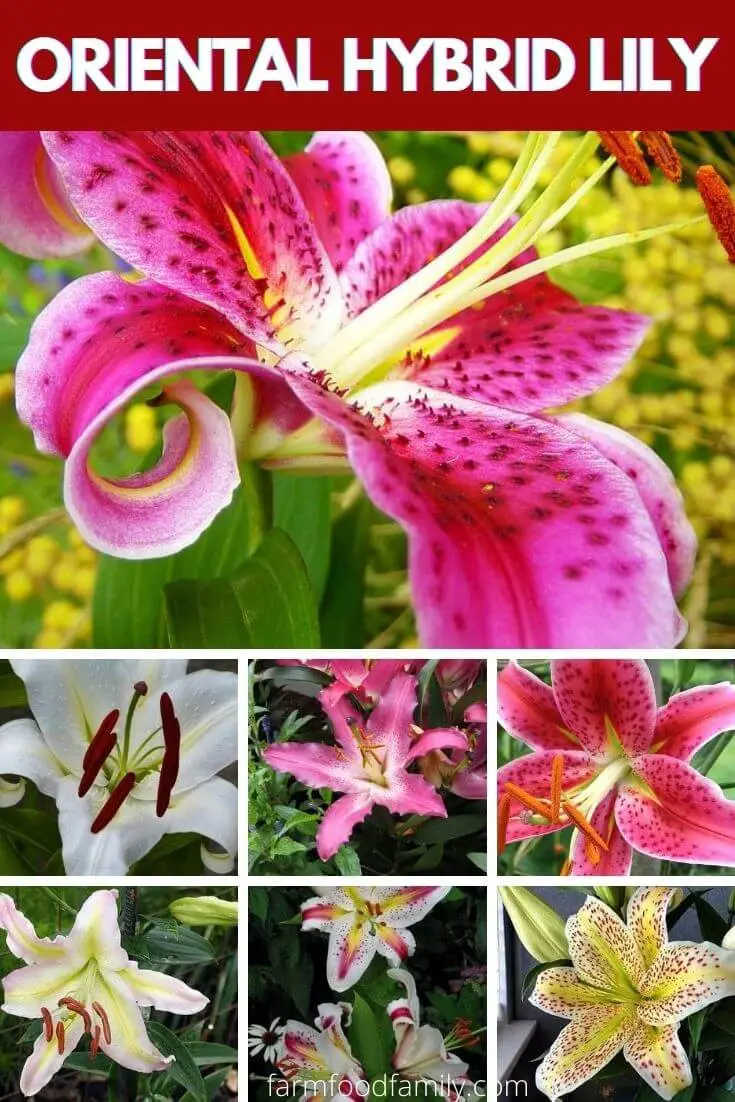
The outcome of crossing L. auratum and L. speciosum is a distinctive flower characterized by its striking features. The blooms feature large, curved, upright petals that unfurl from late summer to early fall, showcasing their vibrant beauty. Notably, these flowers are renowned for their potent, sweet fragrance that fills the air, earning them a spot as one of the most celebrated cut flowers. When mature, they can reach an impressive height of 5 feet, adding to their allure.
Casablanca
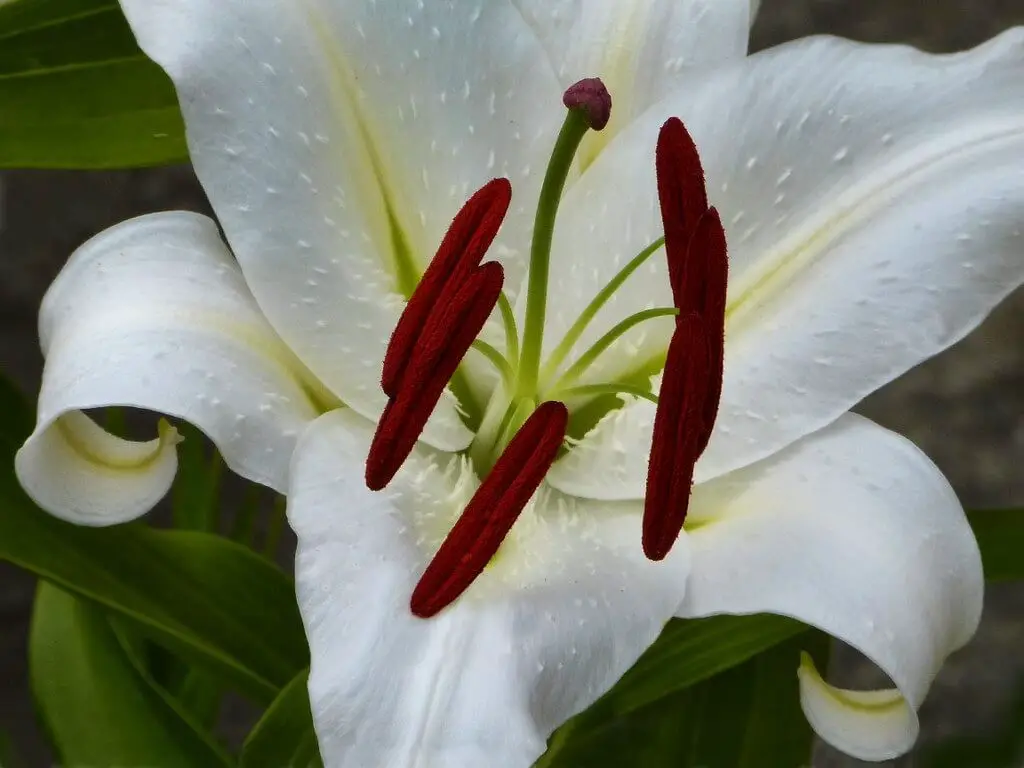
The striking appearance of the plant’s outer-facing blooms is characterized by a crisp, snow-white hue and a vibrant green center. This flowering beauty thrives from the onset of spring through mid-summer, reaching its maximum height of approximately four feet.
Dizzy

The ‘compelling’ daisy boasts striking features, including its pure white petals adorned with vibrant red freckles scattered across the surface. A notable highlight is the defined red stripe running down the center of each petal. This charming bloom is not only visually appealing but also demonstrates a remarkable ability to self-seed and return annually, producing a succession of flowers throughout the summer months.
At its mature height of around 4 feet tall, this daisy variety offers a delightful display of color and texture in any garden setting.
Entertainer

The distinctive feature of this plant is its vibrant pink blooms, adorned with a striking white heart-shaped center. What’s more, each stem typically produces a profusion of 10 flowers throughout the entire summer season. As an added bonus, this annual bloomer has the ability to self-seed, making it a low-maintenance option for garden enthusiasts.
Starlight Express
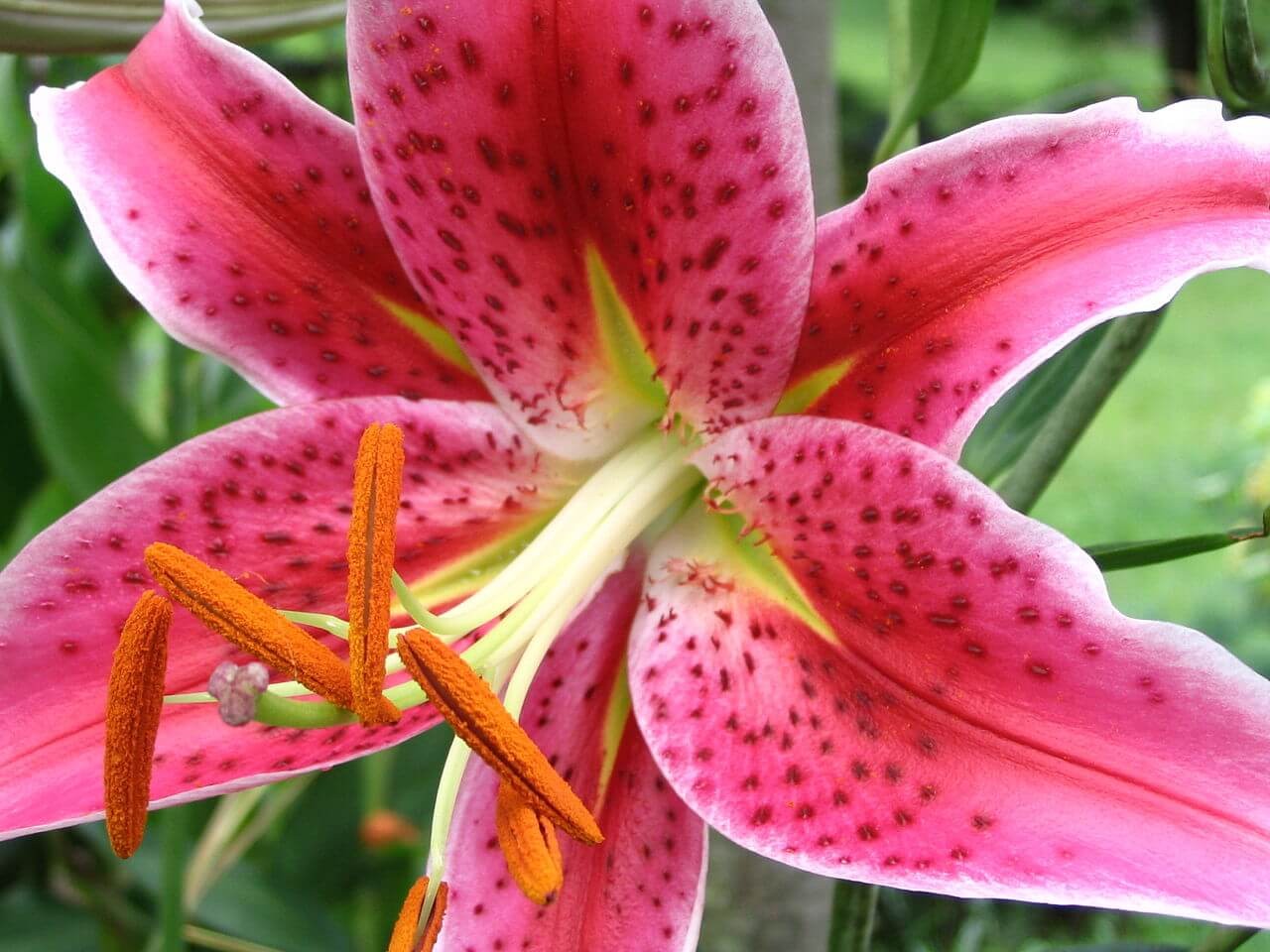
With each stem producing a stunning 15 blooms, the vibrant pink flowers are characterized by their delicate white edging. These bowl-shaped flowers thrive on self-seeding, emerging in mid-to-late summer after a gradual growth period that reaches a maximum height of approximately 1.5 feet.
Tom Pouce

The vibrant blooms of this plant boast a unique combination of soft-pink petals and striking dark brown anthers, with each flower measuring approximately 8 inches in width. The entire plant reaches a height of around 3 feet at maturity. Notably, it produces its annual blooms from mid-summer to late summer.
Love Story
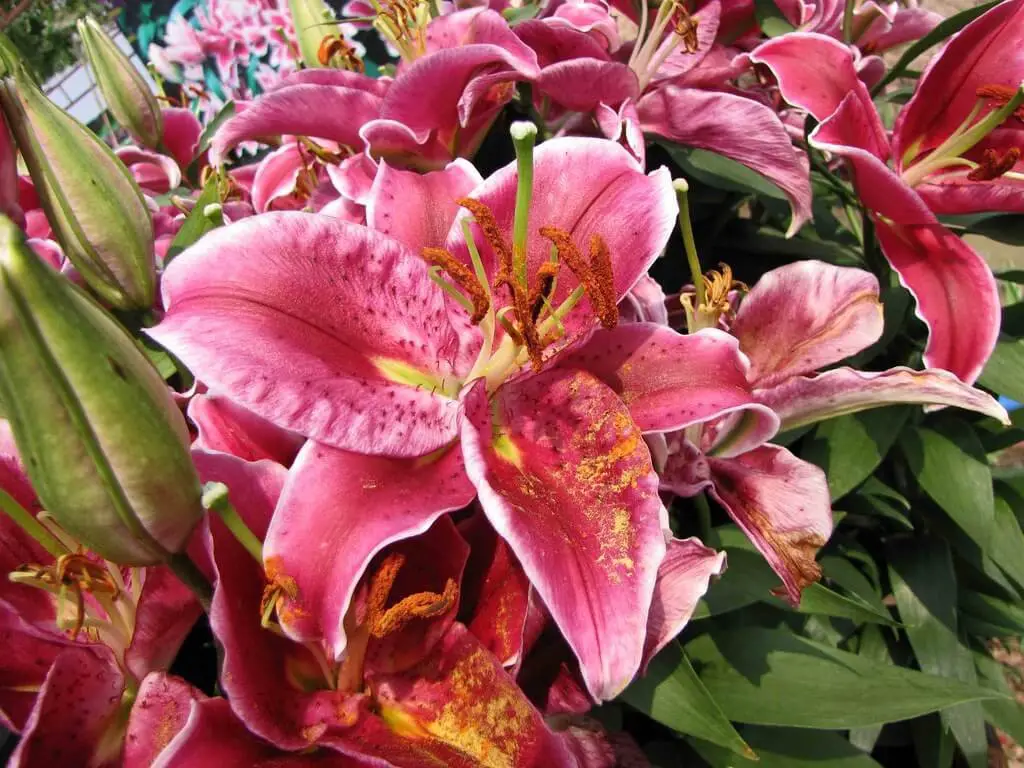
This versatile perennial is equally well-suited as a container flower or border plant, boasting showy crimson-red blooms adorned with white edges and complemented by lush, glossy green foliage. Moreover, it has gained popularity as a sought-after cut flower, producing an abundance of vibrant flowers from late summer through early fall.
Tiger Moon

The daisy-like flower boasts a predominantly white hue, punctuated by intricate brown freckles and striking maroon stamens. At the heart of this lovely bloom lies a bright yellow center. As a perennial, it bursts into bloom annually from July through August, treating onlookers to a vibrant display of color during its brief but spectacular flowering period. Furthermore, this hardy flower is well-equipped to withstand the chill of winter, tolerating temperatures as low as -15°C.
Red Eye
The striking ‘fiery red’ colour of this variety is accentuated by the addition of burgundy spots and crisp white edges. Not only does it boast an impressive level of cold hardiness, but it also boasts a relatively long blooming period, with flowers emerging from July to August. Furthermore, its heady fragrance has earned it a special place in the hearts (and arrangements) of florists, who particularly appreciate its showy, elongated blooms.
Stargazer

One of the most widely recognized and sought-after Oriental hybrid orchids is characterized by its striking appearance. The upward-facing flowers feature recurved tips, while their long, vibrant red-orange stamens add an extra layer of visual appeal. At first glance, the white petals may appear pure, but a closer look reveals a subtle red base with darker red spots. This beautiful bloom persists throughout the summer months, making it a standout in any orchid collection.
Playtime

This stunning flower boasts an extraordinary display of color, courtesy of its pristine white petals, which feature striking stripes of yellow and fuchsia at their center, accompanied by delicate red-pink freckles. As a result, it puts on a breathtaking show from early to mid-summer, further enhanced by its intoxicating fragrance, making it a true delight for the senses.
Division 8: Orient Pet Hybrids

OT lilies, also referred to as such, are found in clusters alongside interdivisional hybrids. Characterized by their robust nature, intoxicating fragrance, and ability to thrive in warmer temperatures than many other lily varieties.
Anastasia

With its distinctive pendant-shaped blooms featuring pink dots radiating from the center towards the edges, this stunning lily variety stands out for its intricate beauty. As the seasons transition from mid to late summer, each stem can be expected to support an abundance of 20-30 flowers, making it a premier choice for adding a pop of color to your garden during the warmest months.
Belladonna

This stunning variety of flower can grow quite large, reaching widths of up to 7 inches. Its unique bowl-shaped blooms are a beautiful shade of golden yellow. As for its height, it can reach up to 4 feet tall, providing a striking presence in any garden. This particular bloom type thrives during mid-to-late summer, making it an excellent choice for those who enjoy watching the garden come alive during this time.
Black Beauty
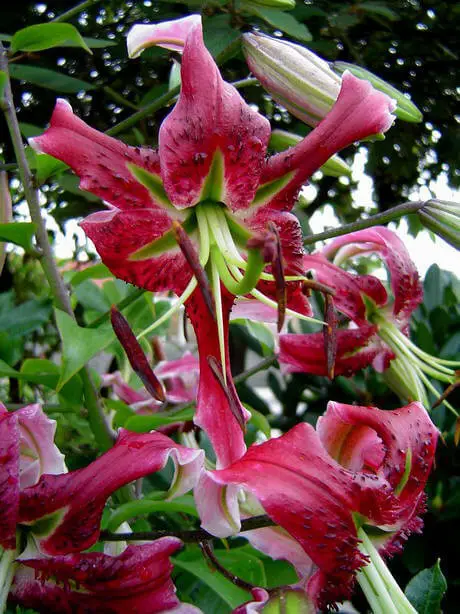
This stunning flower boasts a vibrant display of crimson red petals, delicately framed by white margins and featuring a striking combination of a green, star-shaped center and protruding anthers. Reaching heights of up to 7 feet tall, it’s a majestic sight that can be admired throughout the warm summer months as it blooms continuously.
Flashpoint

The stunning container lily is a standout attraction, boasting delicate old-rose-hued blooms adorned with crisp white margins. As the seasons transition, this ornamental delight begins to unfurl its beauty from mid-to-late summer, reaching heights of approximately 4 feet tall. Notably, the flowers of this lovely plant are known to be toxic to pets, a consideration for any discerning homeowner.
Gluhwein

The Oriental Lily, a renowned flower, boasts an array of striking colors including soft peaches, creamy whites, and warm tones of red on its petals. A distinguishing feature is the golden center, which adds a touch of elegance to the overall appearance. As it blooms throughout the summer season, this stunning flower can grow up to 4 feet in height at its maximum.
Robert Swanson

The striking characteristics of this plant are most prominent in its vibrant, flame-hued flowers that display warm tones of red and subtle undertones of orange. The recurved petals showcase a unique feature – their yellow edges and apple green centers provide a striking contrast. Notably, each bulb is capable of producing an impressive 40 blooms, which typically emerge from mid-summer through late summer, painting the landscape with vibrant colors.
Silk Road

The Friso variety of orchid boasts a striking appearance, characterized by its crimson red petals that gradate to white towards the edges. This vibrant flower is a summer bloomer, meaning it puts on display its stunning coloration and unique shape during the warmer months.
Souvenir
The sunflower’s appearance is characterized by its striking, bowl-like structure, boasting velvety dark-purple pink petals that gently curve upwards. The flower’s vibrant, red-orange stamen and golden center add a pop of color, creating an eye-catching display. Notably, this type of sunflower exhibits self-seeding tendencies, with the blooms appearing annually from mid-summer through late summer.
Division 9: Interdivisional Hybrids
The concept of hybridization refers to the process of cross-breeding specific wild plant species with lily varieties within the first seven divisions. This results in the creation of unique, novel plant combinations.
LA hybrids
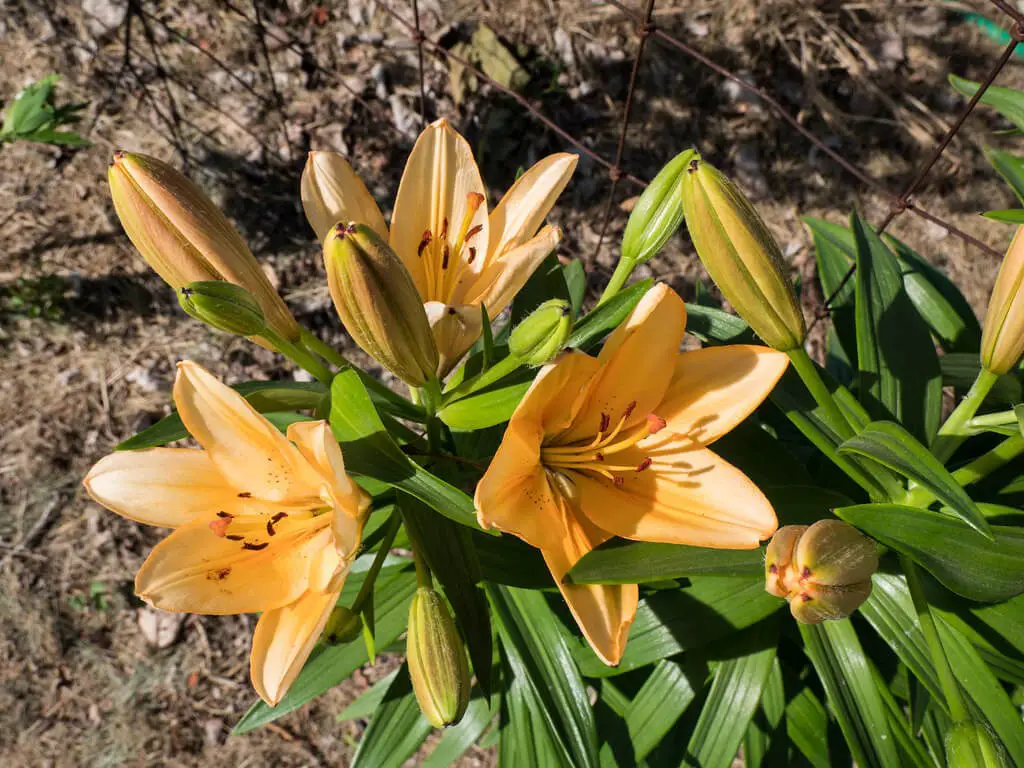
The resulting varieties, born from the union of Asiatic hybrids and L. longiflorum, boast a unique combination of characteristics. Their blooms, which can reach up to 7 inches in height, are not only large but also renowned for their captivating fragrance. Moreover, these flowers tend to have a flat shape, setting them apart from other varieties.
OT hybrids

One type of Oriental lily crossbreed is a fusion of Trumpet/Aurelian lilies. Notably, these hybrids are renowned for their robust growth habits, with the ability to thrive in extremely hot climates. Their impressive blooms are characterized by their large size and outward-facing orientation, while also boasting heavily scented flowers that make them popular for stem cuts.
Division 10: Species & Wild Lilies

The native lily varieties, often referred to as wild lilies or native plant species, are a result of breeding the first eight divisions of lilies together. These plants are indigenous to Europe, North America, and Asia, where they thrive naturally. Interestingly, cultivating these native lilies as hybrids can be more challenging than growing them from seed in their natural environment.
Brindisi

The flower’s vibrant hue is characterized by a striking all-pink colour scheme, featuring a predominantly baby pink tone that gradually deepens to a darker pink towards its centre. A notable feature of this bloom is its ability to flourish throughout the summer months at an impressive height of 4ft tall, with each stem boasting a generous seven flowers.
Lady Alice

The ‘Henryi’ hybrid lily boasts an extraordinary flower, characterized by its distinctive pendulum-shaped petals with a warm apricot-orange hue that gradually transitions to white towards the edges. The bloom’s surface is adorned with cinnamon-toned freckles that extend inward toward the center. This stunning variety thrives during the summer months, treating onlookers to a visually striking display.
Leichtlinii

Native to Japan, the distinctive plant boasts slender stems, a unique characteristic that sets it apart from other varieties. Its golden yellow flowers, which face downwards, are another distinguishing feature, along with the chocolate-brown freckles that adorn its surface. This plant is often mistaken for tiger lilies, but can be easily identified by its summer bloom period, which typically runs from mid to late August.
Pumilum lily

This striking variety produces a profusion of vibrant, scarlet-red blooms adorned with distinctive black spots at their base. Each sturdy stem is capable of supporting up to 30 flowers, which burst forth throughout the entire summer season. As it grows, this plant will reach an impressive height of approximately two feet tall.
Big Brother

When fully bloomed, this stunning flower can unfurl its petals to the size of a child’s face, presenting an outward-facing display of intricate beauty. The delicate white petals are adorned with vibrant yellow streaks that radiate from the center, forming striking stripes that run along the length of the flower, culminating at the tip. This breathtaking bloom is a mid-summer annual occurrence, offering a brief but spectacular show of nature’s splendor.
Corleone
The Blood Lily, a perennial favorite among florists, boasts an impressive display of intensely fragrant, blood-red blooms that reach upwards towards the sun. These striking flowers bear a resemblance to Christmas lilies and offer a long-lasting display throughout the entire summer season.
Flore Pleno

The Double Tiger Lily boasts a unique characteristic – its vibrant orange blooms are double-flowered, boasting an impressive minimum of 45 petals per bloom. The resemblance to traditional tiger lilies is uncanny, thanks to the dark brown spots that cover its petals. Each stem produces at least 25 clustered flowers annually during the summer season.
What is the difference between a daylily and a lily?
While many assume that daylilies and lilies share a common botanical heritage, this isn’t entirely accurate. In reality, these two plants belong to distinct families – Hemerocallis for daylilies and Lilium for lilies. To highlight the key differences between them, let’s examine some notable characteristics. Notably, daylilies are characterized by their rhizomatic growth pattern, whereas lilies grow from bulbs.
Additionally, daylilies display layered petals (three upper petals and three sepals), contrasting with the single bloom featuring an average of six petals found in lilies. Furthermore, while daylilies typically reach a maximum height of 4 feet, lilies can grow up to 10 feet tall. Interestingly, daylily flowers are edible, whereas lilies, in their entirety, are toxic to cats.
Lastly, the fleeting nature of daylily blooms – they only last a day – stands in contrast to the longer-lasting beauty of lily arrangements popular among florists.
What are the most fragrant lilies?
While many Asiatic lilies lack a discernible scent, Martagon lilies are notoriously potent, making them less suitable for arrangements in vases where subtlety is key. On the other end of the spectrum, certain lily divisions boast an intoxicating fragrance that can fill a room. These most fragrant varieties include Oriental hybrids, species of wild lilies, interdivisional hybrids, and trumpet lilies.
Which Lily smells the best?
When seeking a definitive answer, this blog post is unlikely to provide one. However, it’s interesting to note that certain types of lilies are categorized as ‘best-smelling’ within the realm of lily powerhouses. As we’ve already explored the divisions that these varieties fall under, it would be more practical to present to you the most highly-regarded and fragrant lilies out there.
Some notable examples include Madonna lily, Easter lily, Bright star, Copper king, African queen, Golden splendor, and Starburst – each boasting its own unique scent.
What does a lily symbolize?
Across various cultures and religions, lilies have developed a rich symbolic significance. In ancient Greek mythology, lilies were linked to motherhood, fertility, and femininity, with their white petals thought to be imbued with the purity of Hera’s breastmilk. In Chinese culture, lilies represent abundance, good fortune, and eternal love, serving as a poignant symbol of 100 years of devotion.
For Christians, Madonna lilies hold special significance, representing the virtue and purity associated with the Virgin Mary. Beyond these specific contexts, lilies are often seen to embody a broader range of qualities, including prosperity, enjoyment, gratitude, passion, and virtue.
What does a lily plant look like before it blooms?
Lilies begin their life cycle as bulbous plants, characterized by closed flower-like structures that resemble squash blossoms – minus the characteristic hairy base. This unique appearance serves as a natural hiding place for the bulbs until they’re ready to burst forth into bloom.
When grown from seeds, it may take one to two years before these hidden treasures emerge, giving you ample opportunity to appreciate their development and eagerly anticipate the moment when they finally unfold into beautiful blooms.
How many times will a lily bloom?
To encourage annual blooms from lilies, it’s essential to provide optimal conditions and gentle care. As the flowers fade, the leaves will naturally wilt and die, but prematurely cutting them off can actually hinder future blooming. The solution lies in allowing the foliage to complete its natural cycle. In late fall or early spring, carefully cut back the dead leaves, using them as a nutrient-rich mulch for other rapidly growing plants you’ve planted nearby.
Why is Lily called the flower of light?
Ben Jonson’s poem is credited with the allusion to lily as the flower of light. In this poetic work, the lily serves as a metaphor for life due to its unique characteristic of blooming in full splendor during the day. As it spreads brightness around itself, the lily symbolizes purity, peace, love, and happiness, solidifying its reputation as a true embodiment of light.
Although its blooming period is relatively short-lived, the lily’s radiant essence endures, making it an enduring representation of life’s illuminating aspects.
Where do lilies grow?
Lilies thrive in environments where the soil is consistently moist but not waterlogged, with full sun to partial shade. They are particularly fond of well-draining soils rich in organic matter, which can be achieved through the use of mulch. In temperate climates, lilies typically require at least half a day of direct sunlight, while in hotter regions, they may need protection from the intense afternoon sun.
As for their natural habitats, lilies are native to temperate climates across Asia, including Japan, Taiwan, and mainland China, as well as parts of Europe such as the Balkans and the Mediterranean region, and North America, with some species found in Canada.
Will lily come back every year?
With proper care and a suitable environment, lilies can thrive for years to come. When given the right conditions, these stunning flowers will reliably return each year, producing a show-stopping display of blooms that typically lasts between two to four weeks, depending on factors such as soil quality and sunlight exposure.
Conclusion
Lilies have earned their reputation as a beloved flower for numerous reasons. One of the primary advantages is their low maintenance requirements, making them accessible to gardeners of all skill levels. Furthermore, there’s an incredible diversity among lily varieties, with hundreds to choose from, each boasting unique characteristics such as varying shapes and colors. You can opt for compact, low-growing cultivars or tall-stemmed ones that produce cascading blooms.
With so many options available, it’s virtually impossible to go wrong with a lily. Whether you’re looking at their botanical characteristics or symbolic significance, lilies consistently deliver.
Related Posts
When it comes to flower delivery, the age-old question remains: do you tip your floral courier? While gratuities are always appreciated, understanding the cultural norms and expectations surrounding tipping in the floristry industry can be tricky. For instance, some customers may choose to leave a small token of appreciation for their local florist or delivery service, while others might opt out altogether.
Furthermore, certain regions or cities may have distinct tipping customs that vary from those found elsewhere. Taking into consideration the unique circumstances surrounding your flower delivery can help ensure you’re showing proper respect and gratitude.
In addition to exploring the world of tips and gratuities, this blog also delves into other topics such as identifying and removing weeds with yellow flowers, growing colorful perennials for partial shade gardens or containers, and providing care tips for African violet plants. Additionally, we’ve explored the profile and growth requirements for Astilbe, a flowering perennial perfect for brightening up shady garden corners.
Lastly, our top ten list of shade perennials suitable for cold climates provides valuable insights for creating a lush and thriving shade garden.


